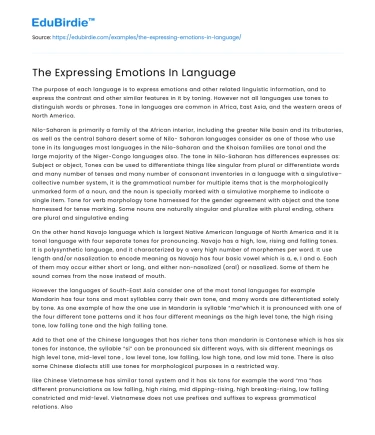The purpose of each language is to express emotions and other related linguistic information, and to express the contrast and other similar features in it by toning. However not all languages use tones to distinguish words or phrases. Tone in languages are common in Africa, East Asia, and the western areas of North America.
Nilo-Saharan is primarily a family of the African interior, including the greater Nile basin and its tributaries, as well as the central Sahara desert some of Nilo- Saharan languages consider as one of those who use tone in its languages most languages in the Nilo-Saharan and the Khoisan families are tonal and the large majority of the Niger-Congo languages also. The tone in Nilo-Saharan has differences expresses as: Subject or object, Tones can be used to differentiate things like singular from plural or differentiate words and many number of tenses and many number of consonant inventories in a language with a singulative–collective number system, it is the grammatical number for multiple items that is the morphologically unmarked form of a noun, and the noun is specially marked with a simulative morpheme to indicate a single item. Tone for verb morphology tone harnessed for the gender agreement with object and the tone harnessed for tense marking. Some nouns are naturally singular and pluralize with plural ending, others are plural and singulative ending
Save your time!
We can take care of your essay
- Proper editing and formatting
- Free revision, title page, and bibliography
- Flexible prices and money-back guarantee
On the other hand Navajo language which is largest Native American language of North America and it is tonal language with four separate tones for pronouncing. Navajo has a high, low, rising and falling tones. It is polysynthetic language, and it characterized by a very high number of morphemes per word. It use length and/or nasalization to encode meaning as Navajo has four basic vowel which is a, e, I and o. Each of them may occur either short or long, and either non-nasalized (oral) or nasalized. Some of them he sound comes from the nose instead of mouth.
However the languages of South-East Asia consider one of the most tonal languages for example Mandarin has four tons and most syllables carry their own tone, and many words are differentiated solely by tone. As one example of how the one use in Mandarin is syllable “ma”which it is pronounced with one of the four different tone patterns and it has four different meanings as the high level tone, the high rising tone, low falling tone and the high falling tone.
Add to that one of the Chinese languages that has richer tons than mandarin is Cantonese which is has six tones for instance, the syllable “si” can be pronounced six different ways, with six different meanings as high level tone, mid-level tone , low level tone, low falling, low high tone, and low mid tone. There is also some Chinese dialects still use tones for morphological purposes in a restricted way.
like Chinese Vietnamese has similar tonal system and it has six tons for example the word “ma ”has different pronunciations as low falling, high rising, mid dipping-rising, high breaking-rising, low falling constricted and mid-level. Vietnamese does not use prefixes and suffixes to express grammatical relations. Also there are similarity between Chinese and Vietnamese they both have a classifier system: a noun used in a definite noun phrase, with a numeral or with a focus marker, must appear with a classifier, and their strategy for forming wh-questions.
Finally Thai which is spoken as a first language by 20 million speakers and as a second language by 40 million speakers in Thailand has five tones as example for the word” na” it has different meaning with low falling, high falling, high rising, low falling-rising and mid falling.






 Stuck on your essay?
Stuck on your essay?

